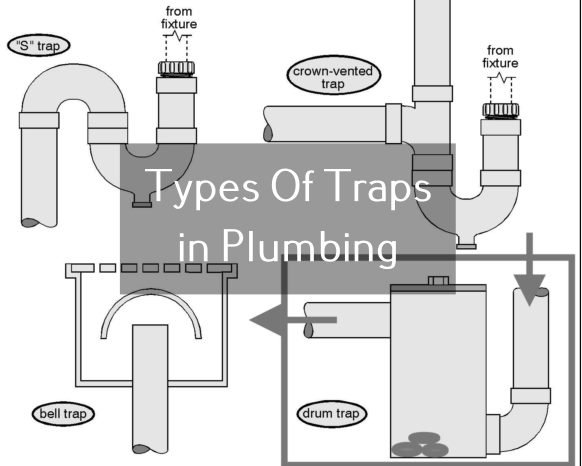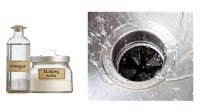Plumbing seems simple to understand, but there’s much more than what meets the eye. To know more about it, read about the types of traps in plumbing below, which shape how it will take the draining waste and water with it.
Five Different Types of Plumbing Traps
The plumber system has improved over the centuries and decades but still maintains the same basic principle. Each fixture should come with a trap and must be equipped with a vent.

Therefore, you can imagine how many pipes in your houses go down to drain waste and go up towards the outside air.
So, what are traps? In a plumbing context, it is a pipe with a bending shape that retains fluid. The trap must be installed on all appliances that use water inside the house.
Its purpose is to allow the waste substance to go through while preventing sewer gases from getting into the building. It also prevents harmful microorganisms such as bacteria or small animals like insects from entering your property.
“A trap is a plumbing device with a curved pipe channel that holds fluid to block sewage gases from entering a building while allowing solid waste to flow out. Methane, carbon monoxide, and hydrogen sulfide are a few examples of the toxic gases that can be released from sewage, which is why traps in the plumbing system are essential.”
Different trap shapes and arrangements, such as the depth of seal, provide a seal for passing water and waste. Below, you’ll read the passage that describes different types of traps commonly found in property buildings.
Read also: Why There Is Water Leak Inside Refrigerator
1. P, Q, and S-Shaped Trap
These types of plumbing traps are classified based on their alphabet-like shape. These three traps basically comprise a U-tube that maintains water as the seal between the air and smelly gas. S-traps used to be popular in drain technology as early as the 20th century.
However, the trend shifted more toward half S-trap, which is now known as P-trap. Meanwhile, a Q-trap is typically used under the closet for the toilet. It has a similar shape as the S-trap, although it’s more commonly used for the upper story than the ground floor.
“Modern plumbing regulations no longer permit S-traps. Most, if not all, jurisdictions in the U.S. have banned using S-traps in new construction, and S-traps must be replaced with P-traps in older buildings. P-traps, with their U-shaped bends, filter incoming effluent as it enters the drainage system, maintaining a water seal that prevents sewer gases from entering the house.”
2. Floor Trap
This trap type is installed on the floor. It’s typically used to collect waste from various house areas, such as bathrooms, kitchen sinks, wash areas, and more.
3. Austindo or Gully Trap
The Gully trap is mainly installed outside the building. It connects the drain system to the sewerage line in the property’s outdoor area. This trap can collect water and waste from the bathroom, kitchen sink, wash area, etc.
“Gully traps are built outside the building to carry wastewater discharge from washbasins, sinks, and bathrooms. They are connected to the nearest building drain/sewage to prevent filthy sewer gases from entering the residence. These are deep seal traps with a minimum water seal depth of 50 mm. It also stops cockroaches and other insects from entering waste pipes carrying wastewater from the sewage line.”
4. Bottle Trap
This particular type of trap is also used to gather water and waste from house appliances. However, it is often used for appliances that do not come with the attached strap.
5. Grease Trap
A grease trap is connected to one or several fixtures and is installed inside the drain pipe. Its purpose is to separate grease through the water and retain it.
“Grease traps work to prevent thick oil and solid pieces from entering a kitchen’s wastewater system and causing damage. They are used in all restaurants and fast food establishments, preventing hazardous clogs or grease leaks, which could result in costly repairs or replacements.”
Common Plumbing Traps
| Trap Type | Description | Common Usage | Water Seal Depth |
|---|---|---|---|
| P Trap | Similar to the S-trap, used in upper stories, prevents sewer gases | Sinks, showers, bathtubs | 50-75 mm |
| Q Trap | Older buildings to be replaced | Toilets, upper floors | 50-75 mm |
| S Trap | Outdated, replaced by P-trap, prevents sewer gases | Similar to the S-trap used in upper stories, prevents sewer gases | 50-75 mm |
| Floor Trap | Installed on the floor, collects waste from multiple sources | Bathrooms, kitchen sinks, wash areas | 50 mm minimum |
| Gully Trap | Built outside, connects drain system to sewerage line, prevents sewer gases and insects from entering | Exterior wastewater discharge | 50 mm minimum |
| Bottle Trap | Used with appliances without built-in traps, easy to clean | Washbasins, kitchen sinks | Varies |
| Grease Trap | Separates grease from wastewater, prevents clogs and damage | Restaurants, fast food establishments | Varies |
Plumbing traps can be manufactured as the built-in trap that comes with your appliance, or they can be separate items connected to the appliance outlets for water and waste. No matter what types of traps you use in plumbing, they should be convenient enough to clean and sustain an effective water seal under various flow circumstances.


